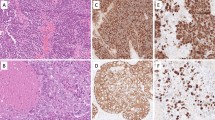Abstract
Hepatoid adenocarcinoma is reviewed in its clinicopathological and oncogenetic aspects. This variant of adenocarcinoma has been found to be an alpha-fetoprotein (AFP) -producing carcinoma arising in extrahepatic organs, and it mimics hepatocellular carcinoma in terms of morphology and function. Vascular invasion, usually prominent, is often complicated by extensive liver metastases. A prompt and accurate diagnosis of hepatoid adenocarcinoma is important because the prognosis is very poor compared with that of common types of adenocarcinoma. The characteristic features of hepatoid adenocarcinoma are summarized on the basis of our own experiences and the literature. In addition, a possible molecular mechanism that under-lies the ectopic appearance of the hepatic phenotype is discussed.
Similar content being viewed by others
Author information
Authors and Affiliations
Additional information
Received: August 22, 2000 / Accepted: August 23, 2000
Rights and permissions
About this article
Cite this article
Kishimoto, T., Nagai, Y., Kato, K. et al. Hepatoid adenocarcinoma: a new clinicopathological entity and the hypotheses on carcinogenesis. Med Electron Microsc 33, 57–63 (2000). https://doi.org/10.1007/s007950070002
Issue Date:
DOI: https://doi.org/10.1007/s007950070002




